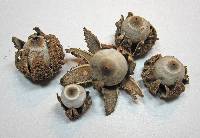
|
|
|
|
Family: Geastraceae
|
Geaster arenarius Lloyd: Lloyd, C.G. 1902. The Geastrae. Mycological Writings 7: 28. Exoperidium subhygroscopic, cut to five to ten segments; drying usually with segments incurved. Mycelial layer closely adnate with adhering sand. (*) Fleshy layer closely adnate, light color, not rimose. Inner peridium subglobose, with a very short but distinct pedicel in some specimens, in others appearing sessile. Mouth even, conical, acute, definite and usually darker colored than remainder of inner peridium. Columella indistinct. Spores globose, rough, 3-4 mc.
Specimens in our Collection. Florida, H. C. Culbertson, C. G. Lloyd, (both from the sand at Jupiter, Florida.)
|













